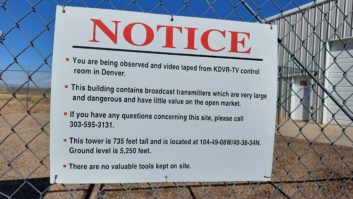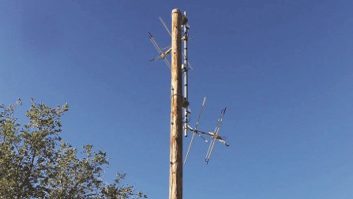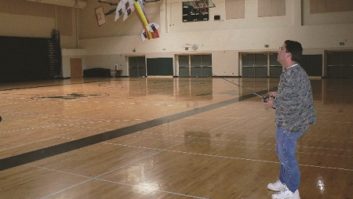(click thumbnail)Fig. 1 Zap! The sign at right says it allLet’s start the column with a laugh.
Actually, Fig. 1 won’t be funny if someone gets shocked. But the warning symbol on the electric box to the right speaks volumes.
It only takes a couple of minutes to do things right. Take the time, you’ll sleep better at night!

. . .
Joe Schloss, chief of KICD(AM-FM) and KLLT(FM) in Spencer, Iowa, starts us off with a suggestion to keep for that rainy day – you know, when the gray cloud just seems to park over your head.
When a piece of 50-ohm rigid transmission line inner conductor fails, and all you have is a piece that is too short, remember this temporary fix. Plumbing supply houses sell what is known as a 1-inch sweat coupler. It fits nicely inside of the copper inner conductor.
Flux the connection and silver solder. Don’t use soft solder!
Once you’re soldered the connection, file the edges smooth and install. Joe explains that the line impedance is set by the distance from the outside of the inner conductor to the inside of the outer conductor. By making the splice on the inside of the inner conductor, it affects the line impedance less.
. . .
Damian Centraf is the chief engineer for Herald Broadcasting’s WSHB Shortwave station in Pineland, S.C. He suggests you add a digital camera to your “must buy” list.
Damian uses his as a troubleshooting tool. It not only works great for documenting troubles, but also displaying where wires go, or for e-mailing pictures to vendors for replacement parts. Even cheap digital cameras can be useful, and the prices keep falling.
Damian has used his camera to capture an image sent to a tech support person in the middle of the night, to help convey a problem. After the camera, Damian places a scanner high on his list.
He has scanned important documents into his computer, saved them on a CD-R, and can carry his technical library along with his laptop. If you know how to use your directory tree structure, you can catalog pictures and documents with titles you recognize. The process also lets you keep track of fixes. If you have repeatable problems, the logging can save a lot of time.
For group DOEs or market chiefs, a digital picture gallery of each radio station’s equipment and layout can speed troubleshooting by phone. You can be looking at the picture of the equipment while you talk your operator through a diagnosing process.
(Editor Paul McLane adds this thought: Digital photos make great companions to the tips you send to Workbench. Make sure the resolution is at least 300 dots per inch, which typically translates to a file size of 250 to 500 KB.)
. . .
Remember the Wollensak reel-to-reel recorder I mentioned in the Jan. 16 issue?
The students at Chestertown High School in Chestertown, Ind., got quite a chuckle. They have 14 Wollensaks in use, with another dozen as back-ups.
The students in Brent Barber’s “Introduction to Radio and Video Production” class use them to record practice PSAs and newscasts. The machines are more than 40 years old, and just like the Energizer Bunny, keep going and going and going.
Fig.1 includes advanced students showing off their prized-possessions. If you’ve got a Wollensak or two in your store room, send it Brent’s way. Think of the tax deduction.
By the way, just so we don’t think Brent’s living in the past, he encourages Workbench readers to take a virtual tour to see that the rest of the station’s equipment isn’t as old as the Wollensaks. Visit www.duneland.k12.in.us/chs/wdso/tour1.html.
Isn’t it great to see old equipment being used like this? And who knows, maybe some future engineers will emerge from Brent’s classes.
. . .
Dwight Morgan is the CE for Maranatha Broadcasting in Grand Junction, Colo. Dwight adds a caution to engineers planning tower painting this spring and summer.
Tower painters should never paint anything below the top of the AM tower base insulator.
We showed a picture a few months back in which the static arc gap balls had been painted red. Dwight points out that the static drain should be galvanized, and with no sharp points. In the case of a low tower concrete pier, the air gap could be compromised if grass is allowed to grow around the tower base.
With that in mind, Dwight suggests an application of weed killer around the base of the tower and inside the tower fence, to keep vegetation minimized.
Dwights cautions that if the tower is being painted with paint-gloves, check to make sure that any tower weep holes aren’t left clogged with paint. If you are unfamiliar with the tower crew doing the painting, tell them you will be climbing the tower to inspect the job after they are through, and before final payment is issued.
If you can borrow a climbing belt, to show you mean business, so much the better. Paying a third party to actually climb the tower and inspect the painting is, of course, the best solution.
By the way, a couple of years ago, a reader suggested in this column that you use Sherwin-Williams aviation orange and white paint. It sounded like a great idea. Sherwin-Williams representatives would visit your site, inspect the tower paint, even recommend a painting contractor. How could you lose? A number of stations used this free service.
A problem developed among some stations months later when the Sherwin-Williams paint used on the towers started to fade, and fast. This required a complete repainting, in which Sherwin-Williams agreed to replace the paint but not cover the labor to correct the problem. The cost of the paint was miniscule, compared to the overall labor expense. The result was that many stations paid twice for the same job.
Shame on Sherwin-Williams for not stepping up to the plate. Broadcast engineers (and homeowners, for that matter) have long memories.
This instance brings to mind the need to check the fine print in any painting contract, as well as any warranty. It’s probably a good idea to find out where your painting contractor will be getting their paint, too.
. . .
Looking to make your labeling more professional? Mitch Fine, sales manager for Herman Electronics, is touting a low-priced labeling device, the Brady ID Pal.
It’s a hand-held labeler that prints on four materials: nylon, cloth, vinyl black-on-white, polyester clear and polyester white. Most labelers were designed for office use, but the ID Pal is more heavy-duty and uses no ink.
Printing is done using a thermal process, so if the label gets wet, there’s no smearing of the printed image. Herman Electronics has the Brady ID Pal priced at $139. It has a recharger, but also runs on six AA batteries.
The labeler will yield about 3,500 labels with a fresh set of batteries. For more information, go to www.hermanelectronics.com.
Submissions for this column are encouraged, and qualify for SBE recertification credit. Fax your submission to (703) 323-8044, or send e-mail to [email protected]












